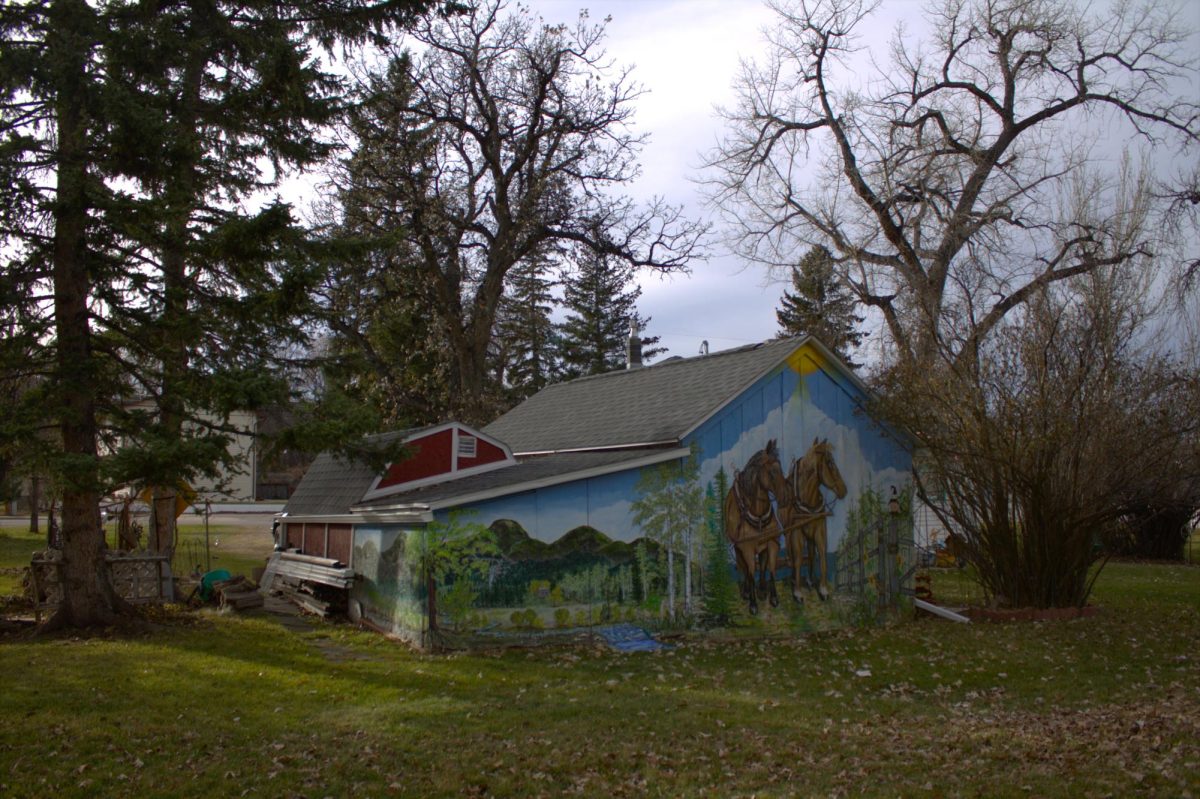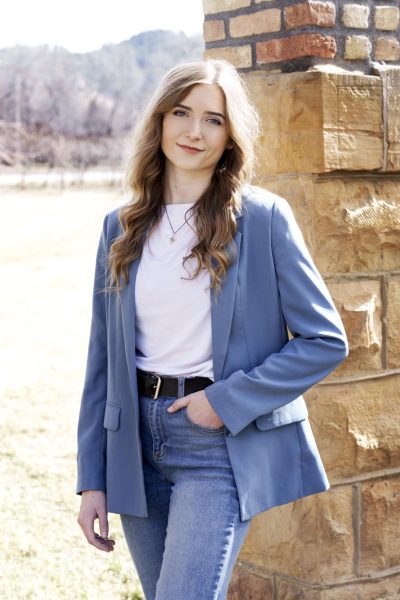The roads were icy. Being somewhat of a newcomer to Spearfish, navigating the semi-intricate grid of avenues and alleys had been tough enough before the snow started falling, and now that black ice had consumed the asphalt I felt as though I was trapped on the frozen lake at the bottom of Dante’s iteration of Hell, Cocytus.
Black ice has never bothered me much, despite it having claimed two of my previous trucks, and I was determined. Determined to get to the house of Terri and Gary Newman, determined to learn about an esoteric piece of Spearfish history.
When I first met Terri Newman, the weather was not yet so malicious. It was late October. I was walking the Spearfish Recreational Path through Brady Park, following the town’s titular creek. Toward the north end of the path, I saw a woman painting a mural on the back of an old building.
The mural was large, covering the entire wall, and centered around a team of two horses, complete with the hitches and rigging expected on a working draft pair. I stood and watched from a distance for a couple seconds, before deciding to walk over and make a little small talk.
She had earbuds in and was completely enveloped in the music she had chosen. I approached from the side, hoping she would see me before I got too close and startled her. That did not happen.
After the initial shock and introductions, Newman could not have been more pleasant to talk to. Upbeat and cheerful, we first spoke about how nice the weather was and how the grass was still as green as ever. Then the conversation turned toward the mural.
“So, this is Daisy, and that’s Maisy,” Newman said. “They were my great-grandmother’s horses.”
She went into the tale of Mary Carney, her great-grandmother, recounting important dates and events pertaining to the experience of homesteading in the Black Hills, including love, loss, good times and bad.
Terri eventually asked if I’d be willing to get up on a ladder and add some asymmetry to the painted clouds. Happy to oblige, I was handed some white paint and a brush. Stretching to provide definition and clarity to the haze, we continued talking about life in the Dakotas, Wyoming, and Montana.
By the end of that first conversation, I knew I had to return and learn more.
Half a week later, I had conquered the icy roadway. Pulling into the Newman’s driveway, I immediately got a sense of homeliness. It was clearly a very old house but radiated stability and the energy of an immovable object, a survivor of time.
Walking around the side of the house brought another structure into view, the old building on which the mural had been painted. I walked up the stairs, across the porch and was greeted warmly by both Newmans.
Gary sat at the dinner table, a laptop and a spread of obituaries in front of him. Terri immediately offered to make some hot cocoa, and before I could respond she was already halfway done. Good people.
I sat down and started to prepare a recording. Terri joined us at the table, placing down mugs and old picture books. Then she started talking about her great-grandmother.
Mary Carney (then Mary Deathe), first came to the Black Hills as the bride of George Deathe in 1879. They first settled in the Central City area, between Lead and Deadwood, and later moved to the now-ghost town Terraville.
Two years later, they found themselves in the Spearfish Valley, homesteading on a ranch until George fell ill with Bright’s disease. He died in 1891, and Mary remained on the ranch for another two years. During this time on the ranch they acquired Daisy and Maisy, their beloved team of draft horses.
After George died, Mary was forced to face the fact that women couldn’t own land. She decided to marry her hired ranch-hand, Andrew Carney, and purchased the land for the price of her matched team of mares, Daisy and Maisy.
The town put the horses to work carrying supplies and tools for building projects and road work. “She always was sad about how
she watched her horses overworked through the next three decades,” Terri said. “Daisy and Maisy worked very hard developing Spearfish’s infrastructure.”
Mary Carney remained with Andrew in Spearfish for many years, until eventually uprooting and homesteading in Mona, Wyo., near Devil’s Tower. In 1902 they returned, purchasing a ranch on Spring Creek, between Spearfish and St. Onge.
Andrew died in 1916, and Mary remained a widow for 34 years until her death in 1950 at the age of 91.
“Family stories believe Daisy and Maisy lived until about the mid 1920’s,” Terri said. “[We] estimate a life of over 30 years.”
Terri spoke with confidence – she knew the story well. Gary stepped in from time to time, to clarify a date or who-married-who in the more extended branches of the family.
“This was the original property [Mary] bought,” Terri said. “This is the house, and that’s Daisy and Maisy’s original stable.” I realized that the stable had been the building upon which Terri painted the mural.
We had come to the point of our conversation that justified her breaking out old photographs and memoirs. The pictures were remarkably well preserved, even the few of Mary Carney and George Deathe from when the two first married.
Terri disappeared into an adjacent room then, still speaking about that particular photo. When she reappeared, she held a black blouse on a hanger in her hand.
“This is the very same shirt Mary is wearing [in the photograph],” Terri said. “The dress she was married in.”
The blouse was in astonishingly good shape, considering it was nearly 150 years old.
“See how small it is?” Terri said. “She was a very short lady. [In the photograph] you can see how George is sitting down and is still taller than Mary.”
The next pictures I saw were of Terri’s family, her grandparents and their siblings, cousins and uncles. Then photos of the various buildings the family had owned over time.
One in particular caught my eye, it looked like a polaroid of another, much older picture. It was black and white, and very simple. A white house surrounded by dark foliage, beautiful in its very nature.
“I’m not sure when this picture was taken,” Terri said. “It’s of this house, sometime way back when.” A couple more pictures, a couple
more stories, then we steered the conversation back to the mural, and Terri’s love of art.
“[Painting] is my happy place,” Terri said. “The best therapy in the world.” 40 years ago, Terri had a dream to Sketch her great-grandmother’s horses. Growing up with stories about them and hearing how much Mary loved them was an amazing source of inspiration.
She brought out the original sketch, and interestingly enough, the team was in the same position and stance as they are in the mural.
“I had to use a grid and scale it up for the mural,” Terri said. “But I had help from family and friends.” Since the original painting of the horses, Terri has added forests, fields, the surrounding hills, Spearfish Creek and many other details.
“The family believes it will never be completed,” Terri said.
Thinking about the small critters and birds hidden within the acrylic, I remembered how we had watched a praying mantis scale the length of a painted tree the first day we met.
Terri then recounted how her father, local rancher James McDermott, was a professional artist. That fact contributed heavily to her love of art.
Taking me around the house, I wasn’t surprised to see dozens of paintings and pictures, many of which were showcased on what most people would call junk. Crushed watering cans, dented buckets, the works.
“I like to paint these old things,” Terri said. “Breathe new life into them. There is beauty in everything.”
As I left, I felt happy. Happy to have spent time with a wonderful couple, learning some history of the town that will be my home for the next couple years. I was less happy navigating the slickened roundabout, but I quickly forgot those troubles as I realized that 150 years ago, Daisy and Maisy walked these very hills.
“The mural is part of dirt history,” Terri said. “‘Who walked on this dirt before me – before us.’”



